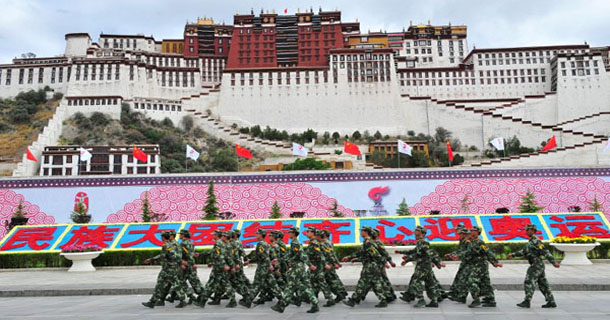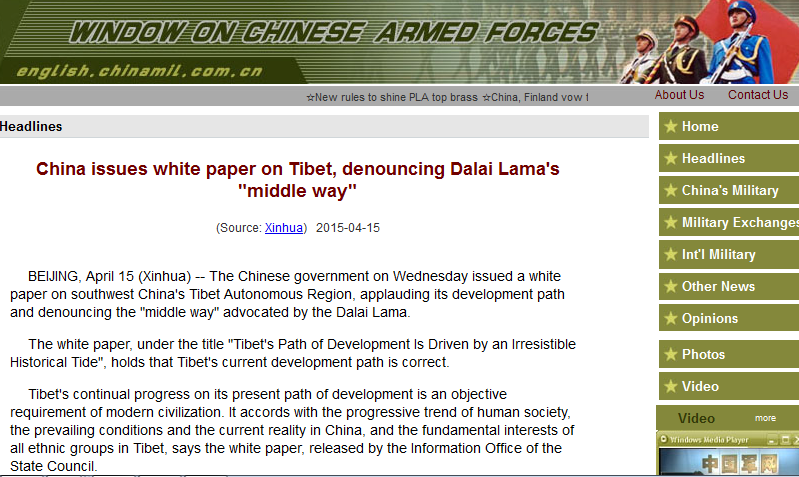
Chinese paramilitary policemen patrol past a slogan reading “Welcome Olympic Games with Our Great National Unity” on displayed in front of the Potala Palace in Lhasa, Tibet, China on June 21, 2008. The Olympic torch relay ended in the Tibetan capital Lhasa, apparently without incident, after deadly riots against Chinese rule in the city just three months ago.
PHOTO: AFP/TEH Eng Koon
The Chinese government has issued their latest White Paper on Tibet this month: Tibet’s Path of Development Is Driven by an Irresistible Historical Tide. This is apparently a belated response to Central Tibetan Administration’s (CTA) renewal of the Middle-Way Approach policy.
The five-point document cites historical sources to argue that neither a completely autonomous Tibet, nor the concept of “Greater Tibet” has ever existed. They outline economic and industrial development that has, in their view, benefited Tibet since the “peaceful liberation”. What then follows is a deliberate attack on the Dalai Lama, specifically linking him to recent acts of violent unrest and selfimmolation, including the publication of a self-immolation guide. They also warn of ethnic cleansing and xenophobia, particularly in the multi ethnic Qinghai-Tibet plateau area, should the Middle-Way Approach be adopted.
The paper dismisses the Middle-Way Approach as unworkable within the constitution of the People’s Republic of China, and claims that the CTA are feigning acceptance of Chinese power in Tibet with the ultimate intention of achieving full sovereignty. Finally, the document reiterates their viewpoint that the CTA and the Dalai Lama should follow the “only sensible alternative” and “to begin to act in the interests of Tibet and the country at large”.
The White Paper states China’s refusal to recognise what it deems as a “separatist political group”, and repeats their assertion that they will not enter discussion with any group naming itself “The Government in Exile”. This ignores the fact that the CTA no longer legally refers to itself as such and that, in further concession, the title of Prime Minister has been replaced with Sikyong which literally translates as “political leader”. The continued entrenchment of China’s position on Tibet is reflected by a lack of reference to this in the published document. The White Paper offers no solution, compromise or middle ground.
In contrast, a number of nations have lauded the non-violent Middle-Way Approach pursued by the CTA, as a win-win approach wherein the Tibetans protect their culture and national identity, while the Chinese maintain the security and territorial integrity of the motherland. The Middle-Way Approach advocates not independence, but genuine autonomy
within the framework of the People’s Republic of China.
White Papers are issued as authoritative reports, dealing with complex issues while presenting the issuing body’s philosophy on the matter.
The CTA dismissed the White Paper as whitewashing the tragic reality in Tibet. They also suggest that this document, the thirteenth issued on Tibet since 1990, is proof that China is having difficulty in gaining credibility internationally for its policies on Tibet.





 Print
Print Email
Email